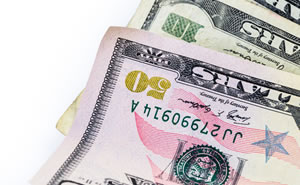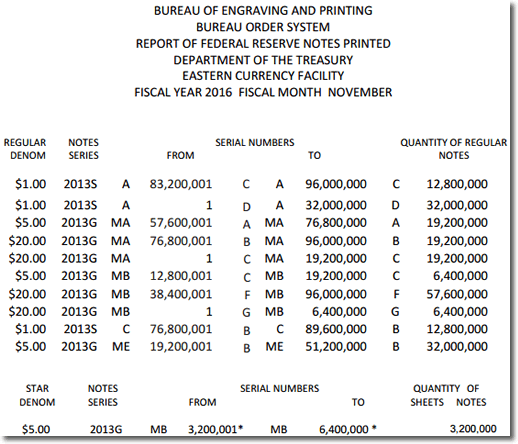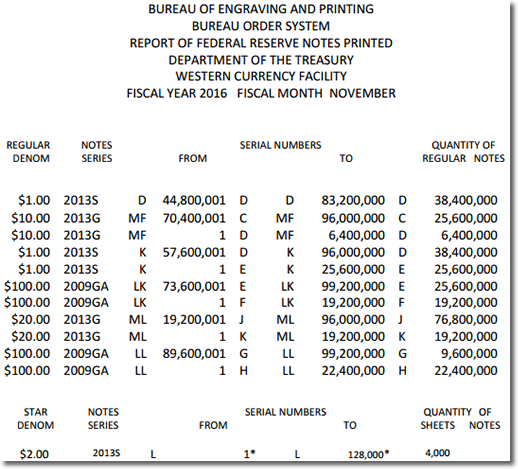 U.S. money production in November dropped to the lowest level since February but picked up slightly from a year earlier, data from the agency responsible for printing American currency shows.
U.S. money production in November dropped to the lowest level since February but picked up slightly from a year earlier, data from the agency responsible for printing American currency shows.
Over 528.1 million in $1s, $2s, $5s, $10s, $20s and $100s came out of printing presses last month, accounting for a combined value of more than $12.4 billion, according to Bureau of Engraving and Printing (BEP) production figures published a week ago Tuesday, Dec. 8. These figures compare to October totals of 784.6 million notes worth over $26.2 billion.
Just two months this year registered fewer banknotes overall, February at 506,880,000 notes and January at 449,104,000 notes.
In percentage comparisons from October to November, there were 32.7% fewer banknotes and they had a 52.7% lower total value. In other monthly differences, there were:
- 18% fewer $1s;
- 99.3% fewer $2s;
- 14% fewer $5s;
- 66.7% fewer $10s;
- 1.5% more $20s; and
- 63.1% fewer $100s.
No $50s were printed for a second month in a row while $2s were produced for a third straight month after a seven-month dry spell.
Compared to the same month a year earlier, the number of notes edged up 2.5% from 515,456,000 and their combined value jumped 47.7% from $8,419,200,000.
Below are images of the BEP’s latest monthly production report. They show the type of banknotes manufactured in November at the agency’s two printing facilities.
November 2015 BEP Banknote Production
Facility at Washington, DC

Facility at Fort Worth, TX

The BEP printed 3.2 millions in $5 star notes and 128,000 in $2 star note. Star notes are replacements for misprinted or damaged notes and for certain serial numbers like 000 000 000. Star notes have serial numbers that end with a star "*" designation, and are also so indicated by quantities in the images above. Money collectors usually find star notes more desirable since they can be harder to find.
The following table lists the type, the amount and the total value of banknotes printed by the BEP for the month:
Banknotes by Denomination: Total Printed and Values
November 2015
| Banknotes | Total Printed | Total Value ($) |
| $1.00 | 160,000,000 | 160,000,000 |
| $2.00 | 128,000 | 256,000 |
| $5.00 | 60,800,000 | 304,000,000 |
| $10.00 | 32,000,000 | 320,000,000 |
| $20.00 | 198,400,000 | 3,968,000,000 |
| $50.00 | – | – |
| $100.00 | 76,800,000 | 7,680,000,000 |
| Totals | 528,128,000 | 12,432,256,000 |
For comparison, four previous monthly money production tables follow.
October 2015
| Banknotes | Total Printed | Total Value ($) |
| $1.00 | 195,200,000 | 195,200,000 |
| $2.00 | 19,200,000 | 38,400,000 |
| $5.00 | 70,720,000 | 353,600,000 |
| $10.00 | 96,000,000 | 960,000,000 |
| $20.00 | 195,520,000 | 3,910,400,000 |
| $50.00 | – | – |
| $100.00 | 208,000,000 | 20,800,000,000 |
| Totals | 784,640,000 | 26,257,600,000 |
September 2015
| Banknotes | Total Printed | Total Value ($) |
| $1.00 | 326,400,000 | 326,400,000 |
| $2.00 | 6,400,000 | 12,800,000 |
| $5.00 | 51,200,000 | 256,000,000 |
| $10.00 | 44,800,000 | 448,000,000 |
| $20.00 | 64,000,000 | 1,280,000,000 |
| $50.00 | 41,600,000 | 2,080,000,000 |
| $100.00 | 144,000,000 | 14,400,000,000 |
| Totals | 678,400,000 | 18,803,200,000 |
August 2015
| Banknotes | Total Printed | Total Value ($) |
| $1.00 | 294,400,000 | 294,400,000 |
| $2.00 | – | – |
| $5.00 | 57,600,000 | 288,000,000 |
| $10.00 | 44,800,000 | 448,000,000 |
| $20.00 | 64,000,000 | 1,280,000,000 |
| $50.00 | – | – |
| $100.00 | 170,240,000 | 17,024,000,000 |
| Totals | 631,040,000 | 19,334,400,000 |
July 2015
| Banknotes | Total Printed | Total Value ($) |
| $1.00 | 166,400,000 | 166,400,000 |
| $2.00 | – | – |
| $5.00 | 64,000,000 | 320,000,000 |
| $10.00 | 51,200,000 | 512,000,000 |
| $20.00 | 121,600,000 | 2,432,000,000 |
| $50.00 | – | – |
| $100.00 | 163,456,000 | 16,345,600,000 |
| Totals | 566,656,000 | 19,776,000,000 |
As a perspective, the BEP in FY 2014 produced about 24.8 million banknotes a day that combined to a face value of approximately $560 million. That pace accounts for about 8.9 tons of ink each day. Also, the agency delivered approximately 6.2 billion notes at an average cost of 10 cents per banknote. The BEP indicates that more than 90% of paper notes printed each year are for replacing those already in, or taken out of circulation.
The BEP operates on a fiscal year that begins on October 1 and ends on September 30. For FY 2016, the Fed has ordered 7.6 billion banknotes.
According to the latest data from the Federal Reserve, there was approximately $1.39 trillion in circulation as of Sept. 30, 2015, of which $1.34 trillion was in Federal Reserve notes.






Has anyone heard why so few $10s are being printed? I rarely receive that denomination in change anymore. Stores are starting to give two fives instead of a single ten, which seems to be counterproductive. Of course for years we’ve been using two quarters instead of half-dollars and multiple $1s instead of $2 bills …. is the sawbuck possibly going to follow suit?
Funny, check out the M1 stats, I THINK BEP has printed more money in the last 10 years than in the prior 50…….
Munzen –
I don’t know for sure why the $10 FRN seems to be “unpopular” but the largest bank in the USA, Chase Bank uses only $20 FRNs in most of their ATMs. I too have noticed i haven’t received a $10 note in awhile.
The last statistics i read show that 60% of all USA FRNs printed each year by the BEP are held outside the USA! Also, some countries like Ecuador use the U.S. dollar as their official currency & the FED ships them notes at their request. Therefore, maybe many $10 notes wind up overseas.
-NumisDudeTX